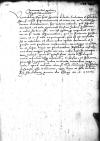List #1852
Ioannes DANTISCUS do Ermland (Warmia) ChapterHeilsberg (Lidzbark Warmiński), 1538-05-01
Regest polski:
Dantyszek domaga się, aby kapituła jak najszybciej przedstawiła mu jasną interpretację artykułu, który stoi jego zdaniem w sprzeczności z roszczeniami finansowymi (pensio aut pensionis reservatio) kantora [Johanna Tymmermanna]. Dantyszek przesyła w załączeniu kopię tegoż artykułu, podkreślając, że jego autorem jest kapituła.
Pozostałe sprawy ma nadzieję omówić osobiście, jeżeli zdoła przed wyjazdem z misją poselską [do Ferdynanda I Habsburga do Wrocławia] przybyć do Fromborka.
Rękopiśmienne podstawy źródłowe:
Publikacje:
| ||||||
Tekst + aparat krytyczny + komentarz Zwykły tekst Tekst + komentarz Tekst + aparat krytyczny Ekscerpty dotyczące podróży Dantyszka
Venerabilibus Dominis,
Venerabiles Domini, fratres sincere dilecti.
Salutem et felicitatem.
Quod Fraternitates Vestras deputaverimus, ut inter nos et venerabilem dominum
Reliqua omnia ad nostrum usque adventum, si forsan, ut speramus, priusquam legationi nobis iniunctae intendere cogamur,[2] apud ecclesiam[3] cum Fraternitatibus Vestris convenire possimus, suspensa esse volumus.
Quae bene et feliciter valeant.


 BCz 1596, p. 482
BCz 1596, p. 482